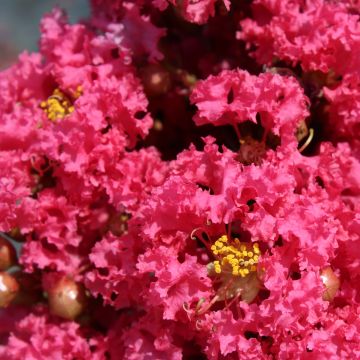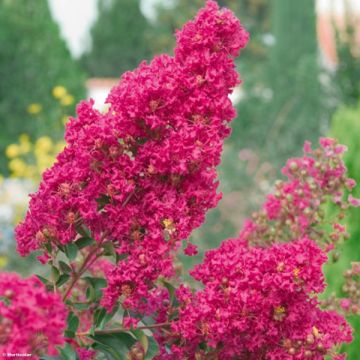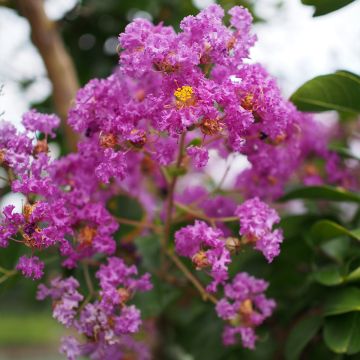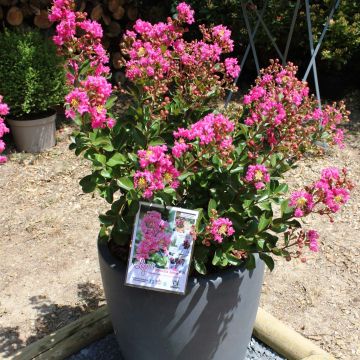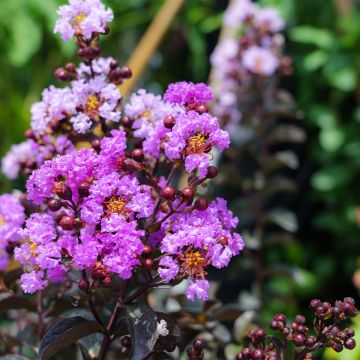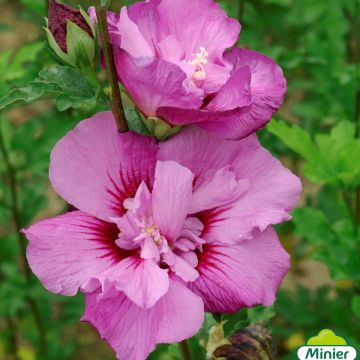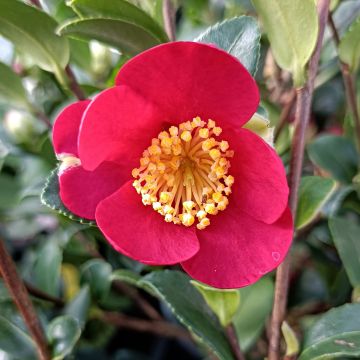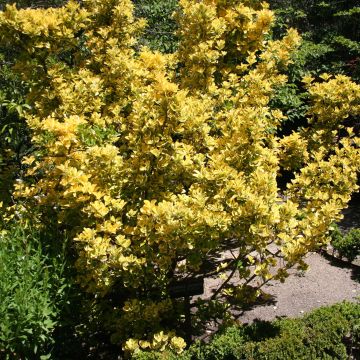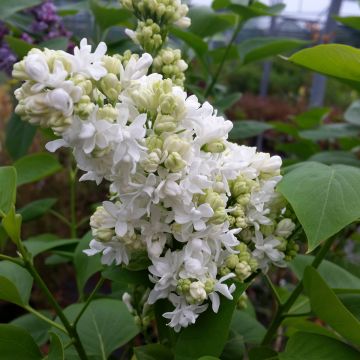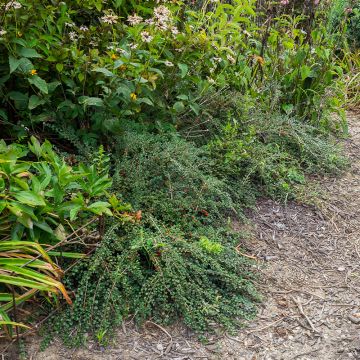

Lagerstroemia indica Black Solitaire Red Hot - Crape Myrtle


Lagerstroemia indica Black Solitaire Red Hot - Crape Myrtle


Lagerstroemia indica Black Solitaire Red Hot - Crape Myrtle
Lagerstroemia indica Black Solitaire Red Hot - Crape Myrtle
Lagerstroemia indica Black Solitaire® Red Hot
Crape Myrtle, Crepe Myrtle, Indian Lilac
Small bush, but it has grown 50 cm (20in) in just a few months. The contrast is impressive between the almost black foliage and the vibrant red flowers. It has perfectly withstood the drought and no powdery mildew. I highly recommend this very original bush that catches the eye.
Serge, 17/08/2020
This item cannot be shipped to the selected country
Delivery charge from €5.90
Delivery to Corse prohibited
More information
Schedule delivery date,
and select date in basket
This plant carries a 24 months recovery warranty
More information
We guarantee the quality of our plants for a full growing cycle, and will replace at our expense any plant that fails to recover under normal climatic and planting conditions.
From €5.90 for pickup delivery and €6.90 for home delivery
Express home delivery from €8.90.
Delivery to Corse prohibited: UE law prohibits the import of this plant from mainland France to Corse as part of the fight against Xylella fastidiosa. Please accept our sincere apologies.
More information
Does this plant fit my garden?
Set up your Plantfit profile →
Description
Lagerstroemia indica Black Solitaire or Black Diamond 'Red Hot', from the astonishing series of Indian Myrtles Black Diamond with almost black foliage, carries clusters of pure red crinkled flowers, a colour all the more brilliant under the midsummer sun as it bursts like a firework against its very dark foliage. Like all Black Solitaire varieties, this Lagerstroemia is more resistant to powdery mildew, and it tolerates both cold and moderate periods or drought well. Summer Lilacs are also appreciated for their richly coloured bark which is ornamental all year round. This one, with moderate growth, is suitable for small gardens and pots.
Lagerstroemia indica Black Solitaire 'Red Hot' is part of a series of hybrids carefully selected in Texas from the 'EBONY' varieties, characterised by very dark foliage. Not exceeding 3 m (9 ft 10 in) in height, these Indian myrtles also stand out for their fairly rapid growth and their ease of cultivation in any well-drained soil.
'Red Hot' belongs to the Lythraceae family, like the Lagerstroemia indica, from which it originates and is native to China. This shrub has a bushy and branched habit from the base, with a slightly erect crown. It will reach on average 2.5 m (8 ft 2 in), rarely 3 m (9 ft 10 in, in height at maturity, with a diameter of 2 m. Its growth is quite rapid. Depending on the climate, it chooses the end of July to start flowering, which will continue until September. The inflorescences are groups of thin pedicels each bearing five petals with a very undulate edge, the texture of which look like that of crepe. They are gathered in dense panicles, at the end of this year's branches.
In 'Red Hot', the pedicels and floral buds are a very dark purplish-brown, then the floral buds open widely into red flowers slightly fading to pink at maturity. The centre of the flowers is highlighted by fine golden yellow stamens. The deciduous foliage retains its very dark burgundy-chocolate-violet colour from spring to summer, then takes on more purplish hues in autumn, before falling. It is composed of small ovate and pointed leaves which are slightly undulate. Finally, and to complete its beauty, its beautiful bark is smooth, beige and striated with brown-red, and flakes to display cinnamon, faded red, old pink, cream marbling.
Indian myrtles are the glory of gardens. Preferring the humid and warm climate, it is a small tree that can also to be acclimatised in a colder area as it can also be quite hardy. Enjoy it as a specimen shrub near the house. It will look good in a shrub bed, a flowering hedge, or emerging from a clump of perennials. Mix into a flowering bed with Campanula pyramidalis, Salvia sclarea or jamensis and Aster laevis. In autumn, it works well with Cotinus and deciduous spindle trees, with all their colour. It also creates a lovely display in a large pot on the patio, when other summer flowering plants are slowing down. Display this plant, Lagerstroemia indica Black Solitaire Lilac with a wonderful carpet of Stachys byzantina, Nepeta mussini and other silver creeping plants weaving like a tapestry around the base of its trunk, highlighting its bark and reflecting the beauty of its bark, its black foliage and its red flowers.
NB: Karl Von Linne named this tree to honour his friend Magnus Von Lagestroem (1696 – 1759), who had sent it to him from India for identification. Originally, this tree was used to decorate Chinese temples. We would like to point out that this tree produces fruits that have are poisonous if ingested.
Report an error about the product description
Lagerstroemia indica Black Solitaire Red Hot - Crape Myrtle in pictures


Plant habit
Flowering
Foliage
Botanical data
Lagerstroemia
indica
Black Solitaire® Red Hot
Lythraceae
Crape Myrtle, Crepe Myrtle, Indian Lilac
Cultivar or hybrid
Other Lagerstroemia - Crape Myrtle
Planting and care
We advise you to plant Lagerstroemia indica 'Black Solitaire' in the spring, after the frosts, in a very sunny and sheltered position. Plant in rich soil which is damp, well drained and if possible non or barely calcareous. It will appreciate the addition of compost and a thick layer of dead leaves, especially for the first two winters in cold regions. Prune the flowering branches very short in February-March, leaving only 4 to 6 buds to balance its shape and stimulate the growth of future flower-bearing branches. If necessary, remove the weak twigs and unwanted branches.
Planting period
Intended location
Care
-
, onOrder confirmed
Reply from on Promesse de fleurs
Hedge shrubs
Haven't found what you were looking for?
Hardiness is the lowest winter temperature a plant can endure without suffering serious damage or even dying. However, hardiness is affected by location (a sheltered area, such as a patio), protection (winter cover) and soil type (hardiness is improved by well-drained soil).

Photo Sharing Terms & Conditions
In order to encourage gardeners to interact and share their experiences, Promesse de fleurs offers various media enabling content to be uploaded onto its Site - in particular via the ‘Photo sharing’ module.
The User agrees to refrain from:
- Posting any content that is illegal, prejudicial, insulting, racist, inciteful to hatred, revisionist, contrary to public decency, that infringes on privacy or on the privacy rights of third parties, in particular the publicity rights of persons and goods, intellectual property rights, or the right to privacy.
- Submitting content on behalf of a third party;
- Impersonate the identity of a third party and/or publish any personal information about a third party;
In general, the User undertakes to refrain from any unethical behaviour.
All Content (in particular text, comments, files, images, photos, videos, creative works, etc.), which may be subject to property or intellectual property rights, image or other private rights, shall remain the property of the User, subject to the limited rights granted by the terms of the licence granted by Promesse de fleurs as stated below. Users are at liberty to publish or not to publish such Content on the Site, notably via the ‘Photo Sharing’ facility, and accept that this Content shall be made public and freely accessible, notably on the Internet.
Users further acknowledge, undertake to have ,and guarantee that they hold all necessary rights and permissions to publish such material on the Site, in particular with regard to the legislation in force pertaining to any privacy, property, intellectual property, image, or contractual rights, or rights of any other nature. By publishing such Content on the Site, Users acknowledge accepting full liability as publishers of the Content within the meaning of the law, and grant Promesse de fleurs, free of charge, an inclusive, worldwide licence for the said Content for the entire duration of its publication, including all reproduction, representation, up/downloading, displaying, performing, transmission, and storage rights.
Users also grant permission for their name to be linked to the Content and accept that this link may not always be made available.
By engaging in posting material, Users consent to their Content becoming automatically accessible on the Internet, in particular on other sites and/or blogs and/or web pages of the Promesse de fleurs site, including in particular social pages and the Promesse de fleurs catalogue.
Users may secure the removal of entrusted content free of charge by issuing a simple request via our contact form.
The flowering period indicated on our website applies to countries and regions located in USDA zone 8 (France, the United Kingdom, Ireland, the Netherlands, etc.)
It will vary according to where you live:
- In zones 9 to 10 (Italy, Spain, Greece, etc.), flowering will occur about 2 to 4 weeks earlier.
- In zones 6 to 7 (Germany, Poland, Slovenia, and lower mountainous regions), flowering will be delayed by 2 to 3 weeks.
- In zone 5 (Central Europe, Scandinavia), blooming will be delayed by 3 to 5 weeks.
In temperate climates, pruning of spring-flowering shrubs (forsythia, spireas, etc.) should be done just after flowering.
Pruning of summer-flowering shrubs (Indian Lilac, Perovskia, etc.) can be done in winter or spring.
In cold regions as well as with frost-sensitive plants, avoid pruning too early when severe frosts may still occur.
The planting period indicated on our website applies to countries and regions located in USDA zone 8 (France, United Kingdom, Ireland, Netherlands).
It will vary according to where you live:
- In Mediterranean zones (Marseille, Madrid, Milan, etc.), autumn and winter are the best planting periods.
- In continental zones (Strasbourg, Munich, Vienna, etc.), delay planting by 2 to 3 weeks in spring and bring it forward by 2 to 4 weeks in autumn.
- In mountainous regions (the Alps, Pyrenees, Carpathians, etc.), it is best to plant in late spring (May-June) or late summer (August-September).
The harvesting period indicated on our website applies to countries and regions in USDA zone 8 (France, England, Ireland, the Netherlands).
In colder areas (Scandinavia, Poland, Austria...) fruit and vegetable harvests are likely to be delayed by 3-4 weeks.
In warmer areas (Italy, Spain, Greece, etc.), harvesting will probably take place earlier, depending on weather conditions.
The sowing periods indicated on our website apply to countries and regions within USDA Zone 8 (France, UK, Ireland, Netherlands).
In colder areas (Scandinavia, Poland, Austria...), delay any outdoor sowing by 3-4 weeks, or sow under glass.
In warmer climes (Italy, Spain, Greece, etc.), bring outdoor sowing forward by a few weeks.


































